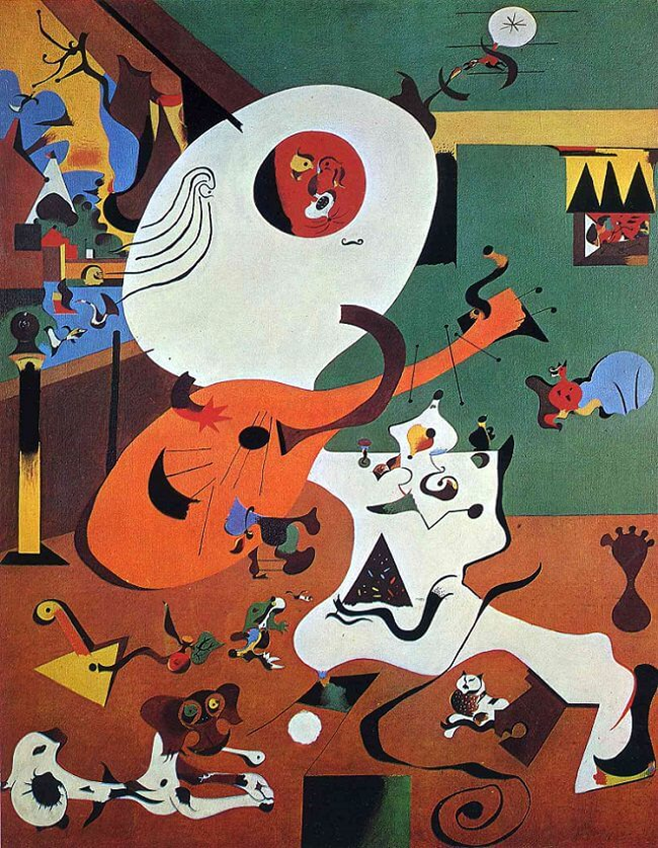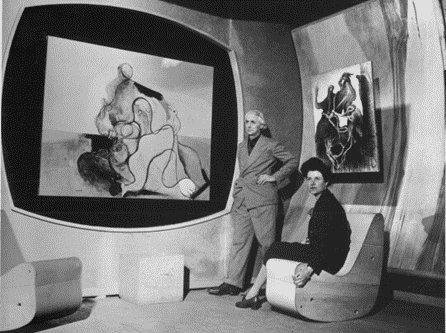THE POWER OF IMAGINATION
PEGGY GUGGENHEIM
Peggy Guggenheim was born in New York City, USA, in 1898.
Her family was very rich and important. All of them loved art, but Peggy was not just a collector, she was also a patron: she financially supported some artists.
In the 1930s, Peggy moved to Europe and lived in Paris, London and Venice.
She became friends with artists like Pablo Picasso, Marcel Duchamp, Max Ernst and Jackson Pollock, among others.
She opened a gallery, Art of This Century, in New York City in 1942.
It wasn't just a place to sell paintings: it was a revolutionary space that showed avant-garde and abstract art, a place for creativity and innovation, for famous or emerging artists.


She helped the Surrealist and Abstract Expressionist art forms become famous.
There were few female art collectors at her time, but she proved that also women could have passion, dedication and love for talented artists.
You can see her personal collection at her home in Venice: the Peggy Guggenheim Museum.
CUBISM
Cubism is an artistic movement created by Pablo Picasso and George Braque in 1907.
During the first period, called Analytical Cubism, artists painted geometric shapes like cubes, spheres, cylinders and cones and used them to show many sides of the subjects they observed - in the same painting.
George Braque, Glass on a Table, 1909-10
Pablo Picasso. Seated Nude, 1909-10
Pablo Picasso: left: Guitar Player, 1910 - right: Portrait of Ambroise Vollard, 1910
The artists didn’t want to copy reality: they wanted to take the world apart and put it back together in a different way.
They analyzed people or objects from different angles and then they painted all their parts on the canvas.
They used very few colours because they wanted the viewer to concentrate on the shapes.
Jean Metzinger, Tea Time, 1911
Pablo Picasso. The Accordionist, 1911
During the second period, called Synthetic Cubism, the painters mixed together different shapes.
They also used more colours.
Pablo Picasso, Swimming on the beach, 1937
Juan Gris, The Violin,1916
They did not use just paint: they often put pieces of newspaper or cloth on the canvas.
This new style of art was called collage.
Pablo Picasso, Bottle of Vieux Marc, Glass, Guitar and Newspaper, 1913
PABLO PICASSO
He was born in Spain in 1881 and died in 1973.
Picasso loved art from when he was a little boy.
His first oil painting, Le Picador, 1889. He was 8 years old.
He didn’t just paint in one style: he had a "
Blue Period" where he used mostly blue colours to show sad and dark feelings; then he had a "
Rose Period" where he used warm colours like pink and orange to paint happy scenes.
The Old Guitarist, 1903
Le Mendiant et l'Enfant, 1903
In his Cubist Period, Picasso mixed up shapes and colours, creating paintings that seemed like puzzles to be solved.
Faces with eyes on different sides, shapes twisted and turned – his art was a playground of imagination!
Weeping Woman, 1937
Portrait of Dora Maar, 1937
Girl Before a Mirror, 1932
His famous painting Guernica is an example of how he expressed also his emotions through art.
In this masterpiece, he depicted the horrors of war, showing the pain and terror of a community under siege.
The Poet
This is a clear example of Analytic Cubism.
Here abstraction is so extreme that objects are very difficult to recognize.
The human form is deconstructed and reconstructed using straight and curved lines in a pyramid.
The small circle at the top can be the eye, connected to the long line of the nose and a curved shape of a moustache under it.
You can then guess a chin, a pipe, a neck, a torso and the arms of a chair.
Picasso destroyed the world into squares and triangles and reassembled it in a new way, to show all the sides of objects and figures at once.
It is a multiple view, as if he moved around his models or objects to make a synthesis of them.
SURREALISM
Surrealism is like a secret door that artists opened to swim into the fantastical sea of the imagination.
Remedios Varo Uranga, Celestial Pablum, 1858
Instead of painting things exactly as they are, surrealists created scenes like dreams full of surprises and unusual combinations of objects.

Yves Tanguy, Indefinite Divisibility, 1942
At the heart of Surrealism is the idea that our dreams and imagination are powerful tools to create art.
Artists believed that, by exploring the mysterious parts of our minds, we can discover amazing stories and ideas.
René Magritte, Golconda, 1953
They loved to use symbols: for example, a clock represents the passing of time or a door can symbolize a new opportunity.
Salvador Dalì, Melting Watch, 1954
René Magritte, Moon Door, 1962
JOAN MIRO’
Joan Miró was born in Spain in 1893 and died in 1983.
He believed that art can be a playground where the mind can fly free.
His paintings are full of playful shapes and colours: they were Miró’s way of speaking the language of his imagination.
Harlequin’s
carnival, 1924
Miró wanted his art to make people happy and curious about the wonderful things around them.
He used colours to create joyful worlds that make everyone smile.
Reds, blues, yellows and greens played together bringing life and energy in a visual symphony.
The Gold of the Azure, 1993
Miró used symbols as personal expressions of his thoughts.
His favorite things to paint were stars and moons. To Miró, they are symbols of dreams and infinite possibilities.
Constellations, 1959
His birds symbolize freedom, spontaneity, his desire to break away from the everyday world and to explore creativity.
Woman and Birds in the Night, 1945 Dutch Interior II
During a trip to the Netherlands in 1928, Miró was inspired by Jan Steen's “The Dance Lesson” for his painting “Dutch Interior II”.
Jan Steen, Children Teach a Cat to Dance, c. 1660 – 1679
The subject of Steen’s painting is the cat, but also the sound, the movement and the happiness of this dancing lesson.
Mirò converted Steen’s painting into abstract form.
He increased the importance of the figures and reduced the objects of the room.
He changed size, position and also colour.
In fact, we first notice the animals and the human figures, before seeing the smaller things around them.
The window is reduced to one small square, at the top of the painting.
He transformed the cat into a squiggle and the laughing child into a floating head.
The skirt of the girl became a deep blue shape.
Miró desired to put "life" in front of everything in this cheerful painting, alive and full of activity.
Here is his transformation of another painting:

 Henrick Sorgh, The Lute Player, 1661 - Dutch Interior I
Henrick Sorgh, The Lute Player, 1661 - Dutch Interior I , 1928
RENE' MAGRITTE
René Magritte was was born in Belgium in 1898 and died in 1967.
He painted ordinary things in extraordinary ways.
He liked to play tricks with our minds by painting familiar objects in unusual settings.
The Therapist, 1937
He painted a pipe and wrote under it: "This is not a pipe."
He wanted us to understand that an image of something is not the same as the thing itself.
The
Treachery of Images,
1928
Magritte painted lots of apples: they suggest hidden truths or obscured identities.

The Listening Room, 1952
He also liked to paint men without a face to create a sense of ambiguity.
Not to Be Reproduced, 1937
Curtains and veils are symbols of what you can see and what you can’t see.
The Lovers, 1928
The sky, sometimes depicted indoors, represents the possibilities of the imagination.
Le Beau Monde, 1962
He loved to paint everyday objects but enlarged to surreal proportion: they are symbols of the absurdity that can be found in the ordinary.
Personal Values, 1952
One of his most famous paintings, The Son of Man, shows a man with an apple hiding his face.
The Son of Man, 1964
This artwork invites us to ask: ‘Who is the man behind the apple? What does it mean?’.
Magritte asked us to explore the mysteries that exist under the surface.
Empire of Light
Magritte invites us on a journey to a place where the ordinary becomes extraordinary.
Empire of Light, 1953, 54 (Peggy Guggenheim Museum Venice)
At the bottom of the painting, there is a house in the night. But if you look up, the sky is bright blue!
Magritte mixed day and night, creating a magical and mysterious scene.
He plays with our ideas of day and night, light and dark, to create a painting that feels both familiar and fantastical.
He invites us to explore themes of duality, contradictions and the subconscious.
He asks us to reflect on the nature of our perception.
Other paintings of the series Empire of Light:
ABSTRACT EXPRESSIONISM
Abstract Expressionism was born after the World War II in the United States.
It was also called the “New York School”.
Artists abandoned the familiar forms of realistic representation and explored the realm of abstraction where emotions, gestures and the act of painting were the most important things.

Lee Krasner -
Milkweed, 1955
Abstract artists wanted to express their inner feelings, not to paint recognizable objects.
They wanted to create art that came from their hearts.

Willem De Kooning, East Hampton XVII, 1968
They used bold colours, energetic brushstrokes and spontaneous gestures.
They wanted to have a more direct connection between the artist and the viewer.
Clyfford Still, PH-129, 1949
With Abstract Expressionism you can let your feelings guide your art, create a dance of emotions and ideas using paint and canvas.
Mark Rothko, Orange, Red and Red, 1962
JACKSON POLLOCK
Jackson Pollock was born in 1912 in the United States and died in 1956.
His style of painting was called "action painting".
He didn’t use a brush: he used to drip, splatter, and fling paint onto his canvases.

He worked on the floor, moving around the canvas, pouring and splashing paint from cans or brushes.
When you look at one of his paintings, you can see layers of swirling lines, splashes of colours and a strong sense of movement.

Alchemy, 1947
His painting Number 1A, 1948 is an example of his style.
It's like a maze of lines that make you feel like you're part of the painting itself.
Number 1A, 1948
Pollock's art wasn't just about the final painting: it was also about the process.
He believed in expressing his emotions and energy through his movements while painting.
Mural, 1943
His paintings didn't have a right side up or a wrong side down. You could look at them from any angle and find something different each time.
Enchanted Forest
It is like a big, colorful adventure that happened on a huge canvas. This painting hasn’t got trees or animals: it shows the spirit of the forest.
Enchanted Forest, 1947
Each layer of paint seems to hold a story, inviting us to walk through it.
The colours - blues, greens, yellows, and reds - blend and collide, form shapes that move and dance across the canvas.
This painting evokes emotions and sparks the imagination.
It has got no borders: it invites us to lose ourselves in its complexity, to find our own meaning in the chaos of colours and lines.
Every viewer can see something different—a hidden path, a secret place or a strange creature.
Pollock here shows that art can also be about the energy and emotions captured in the movement of painting.
AND YOU?
How would you imagine an enchanted forest, an empire of light, a room or a poet?
How would you express yourself in the Cubist, Surrealist or Abstract Expressionist style?
Be creative!
Use the Power of your IMAGINATION!








































































No comments:
Post a Comment